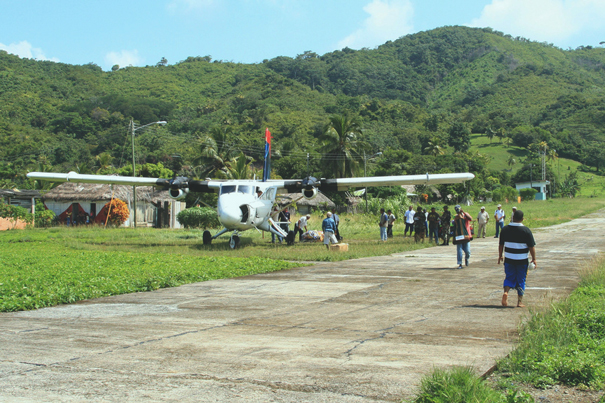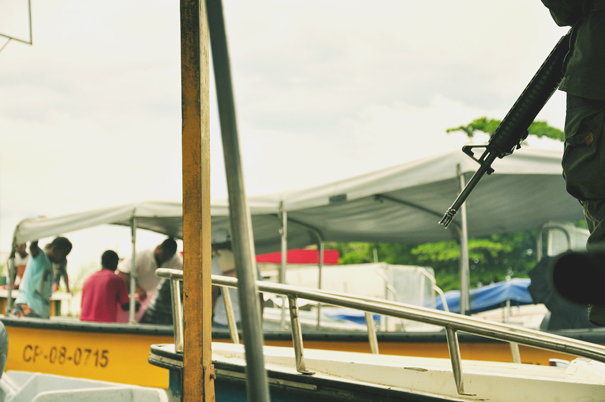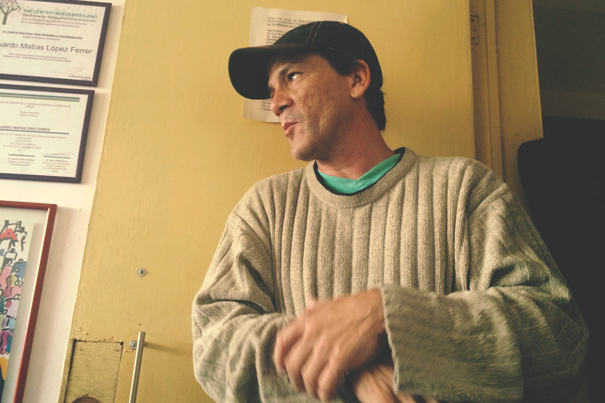
Published in association with IWPR
Soaring numbers of Cubans are attempting to reach the Unites States via its land border with Mexico, fearing that the detente between Havana and Washington may soon end special privileges for Cuban migrants claiming residency in America.
The numbers have increased dramatically since the US-Cuba detente was announced in December 2014. Last year, the number was more than 24,000 entered last year, compared to just 7,759 in 2011.
For years, the preferred route was the risky sea crossing via the Florida Straits, often in improvised craft. Immigrants who crossed in this way were called balseros, or rafters.
The 1966 Cuban Adjustment Act means that citizens can automatically apply for asylum once they reach US territory and are almost certain to be allowed to stay. A 1995 revision to this act means that the US Coast Guard returns those intercepted at sea to Cuba, the so-called “wet foot/dry foot” distinction
This means that arriving by land is not only less dangerous but also more likely to lead to US residency.
In January 2013, the Cuban government abolished their exit permit requirement, opening the way for many Cubans to apply for passports and making the land route even easier.
Most Cubans start their journey in Ecuador, a country that only cancelled visa-free access for Cubans in December 2015.
From Ecuador, migrants can hire a car, take a bus or risk the perilous speedboat Darien Gap crossing between Colombia and Panama.
Others take a more direct route, attempting to enter any part of Mexican territory by sea. Those with connections or money can obtain a Mexican visa at the consulate in Havana, either as tourists, with work permits or via arranged marriages.
The most risky and least popular option, only for the poorest, is to join Central and South American migrants riding the freight train known as La Bestia, the beast. This runs daily from Chiapas on the southern border with Guatemala to the outskirts of Mexico City. Migrants who take this route risk being ripped off by so-called coyotes or polleros, people smugglers, and of falling into the hands of Mexican drug cartels.

Many of the countries on the route through South and Central America offer Cubans guarantees of safe passage as they refuse to cooperate with deportation requests to Cuba.
These migrants often have the advantage of being able to access extra funds from Cuban relatives or charities already in the US.
But this also makes them extra vulnerable to extortion and exploitation along the way.

Rafael Corralero, 42, always wanted to immigrate to the United States.
During the Cuban Rafters Crisis of 1994, when more than 35,000 balseros left Cuba for the US, he helped friends build their makeshift crafts but stayed on the island to look after his sick mother.
Years later, he and his wife Celia decided to take advantage of the visa-free access to Ecuador. They sold everything they owned, raising a little over 13,000 US dollars to pay for their trip to the United States.
They bought tickets to Quito, Ecuador, for 1,100 dollars apiece at the Tame Travel Agency, which also provided tips on how to negotiate at the Ecuadorian border, the first of the eight borders on the long journey to the US.
“After you buy the ticket in Cuba they give you 10 minutes [of instruction]. They give you a kind of class so you can pass [Ecuadorian] migration,” explains Corralero.
Rafael and Celia followed these guidelines when they arrived in Ecuador in July 2015. At the airport they were picked up by their first contact to whom they each paid 1,100 dollars.
The contact put them up for three days before passing them to a Colombian guide to take them to the border. From there, the couple planned to head to Medellín.
Colombia does not issue safe-conduct passes for Cubans. Rafael and Celia say it was of the most difficult countries to cross on their journey.
Colombian police exhorted and threatened them because they knew that Cubans arriving in Colombia generally have the savings to get them to the United States.
The worst part, says Rafael, was the journey to Turbo, the last Colombian city before travellers cross by boat to Panama.
“The journey from Medellín to Turbo is a nightmare. They stop you at checkpoints. When they find out that Cubans are going to pass… the Colombian National Police themselves ask for money: that checkpoint informs the next, and the next.”
Once in Turbo, the couple paid 630 dollars each for the four-hour speedboat trip to Panama.
From Loma La Miel, another speedboat took Rafael and Celia to the border town of Obaldía, where providing services to migrants has replaced fishing as the main source of income for the village’s 670 residents.

From there, light aircraft fly to Panama City every two days.
Once at Panama airport, the Cuban couple were given safe-conduct passes to see them to Costa Rica, Nicaragua and Honduras and then Guatemala.
In Guatemala, the extortion began again. The Guatemalan government does not issue safe-conduct passes and migrants expect to pay 700 quetzals (about 100 dollars) to every police officer that stops them.
“They knew that Cubans were coming,” Rafael says. “There were about 300 of us coming from Honduras through Guatemala.”.
Once more in the hands of people smugglers, Corralero and his wife entered Mexico from the town of El Naranjo in Guatemala. Eventually they reached the town of Villa Las Rosas in the southern Mexican state of Chiapas, where they were hidden in a warehouse and charged extortionate prices for food and drink.
By the time they reach Mexico, many of the Cuban migrants have exhausted their funds or cannot face any more travel. Many hand themselves in at the detention centre in Tapachula on the Mexican border.
Others who are too frightened of deportation take the risk of travelling through Mexico.
On their third day in Mexico, Rafael and Celia were crammed into a refrigerated trailer along with 90 people of different nationalities.
Midway through the journey they had to get out of the trailer “to bypass the [migration] checkpoint. We were like cattle in the rain.”
Once in Mexico they were abandoned by the people smugglers but managed to find help from a priest who took them to the Balsero and Cuban Immigrants House, an NGO headed by Cuban migration lawyer Eduardo Matías López Ferrer.
The couple are still in Mexico, waiting for Ferrer to process their applications with the Mexican authorities so they can travel to the United States. Their families in Miami are trying to find funds to pay for their tickets. They are excited to be close to their final destination.

A work contract with a Mexican company is one of favoured methods of escape for Cubans with money.
The process “isn’t difficult, it’s laborious,” said Antonio Irving, who calls himself a broker and charges 1,100 dollars to process a Cuban’s work contract in the National Migration Institute (INM), a Mexican government body.
There are organised groups who offer advice and administer migration processes working openly around the INM offices. Composed of lawyers, civil servants, INM officials and brokers, these agencies can get a Cuban to Mexico within a month.
Migration consultants claim that their contacts at INM and the Mexican embassy in Havana ensure that there are no problems.
One consultant, who asked to remain anonymous because he is currently employed at the INM, said that he had travelled to Havana for a series of informal meetings with Mexican diplomats to ensure that the permit process ran smoothly.
He explained that fees paid by Cuban clients are used to pay off officials in the INM, embassy, and the airport.
Another method agencies employ is known as ‘the drop.’ This involves putting Cubans without Mexican visas on a plane to Cancun, where they will be met by a migration official who can ensure their entrance into Mexico. This official will also advise them on how to continue northwards, or they are simply taken to the border by car.
"The INM did not respond to requests for comment."
Another option for Cubans who want to enter Mexico is marriage to a Mexican citizen.
This was the option chosen by Roberto Oto, 38, who paid 7,000 dollars for a fraudulent marriage in 2008.
“My friend knew Mexicans who worked in human trafficking, connected to the mafia, I got in touch and they sent me a woman,” Roberto explains.
When his prospective bride arrived in Cuba, they started the paperwork. Roberto paid 800 convertible pesos (CUC) for the marriage certificate, then went to be questioned about his relationship at the Mexican embassy in Havana.
“They were quite rude, they even asked me about the colour of my wife’s underwear,” he says.
When a Cuban marries a foreigner they have to pay 525 CUC for marriage tax, and a further 100 CUC for the protocol tax and 75 CUC to accelerate the process. Roberto had to pay also another 100 CUC for the letter of invitation, the way that Cubans were able to get out of the country legally at the time.
According to the International Legal Consultancy, a law firm based in Havana, both parties to the marriage must present ID documents, a birth certificate, and evidence that they are not already married.
Upon arrival in Mexico, Roberto went to the Cuban consulate to legalise his status with official documents approved by the CJI but they were useless. “They told me that they weren’t valid and I had to get married again in Mexico,” he continues.
This proved to be impossible as by this time Roberto’s wife had disappeared, thinking that he was only going to pass through Mexico on his way to the United States.
“She had already been paid what she was owed for her part and I was just history. I couldn’t rely on her,” he says.
He never saw her again, and found he could not legalise his stay in Mexico without her.
“That’s when I found out that the paperwork with the International Legal Consultancy only worked for a Mexican to legalise their marriage and acquire rights in Cuba,” he explains.
Now in Mexico illegally, Roberto had only three boxes of cigars and two bottles of Cuban rum with him.
Fearing arrest he asked a lawyer for advice. “I don’t know what that man thought of me because his advice was to hide in a sewer and wait for a migration regulation campaign,” says Roberto.
Unable to legalise his migration status, he had one option left.
“The only advantage I had was the certificate that they had given me in the Mexican embassy in Havana, which more or less ambiguously said that I could work with migration’s authorisation,” he says. “I’m a graphic designer but I could only get work as a waiter and other jobs for those who aren’t in a completely legal situation.”
After three years in limbo, Roberto decided to try and reach the US.
“I had heard that Cubans were assaulted for their passports because you’re accepted on the other side [the US] with them. So I had the idea of counterfeiting a student ID. I used everything I had learnt in Cuba as a graphic designer to make it.”
He managed to pass himself off as a Mexican on the bus, but ran into problems close to the border.
“I passed five checkpoints but when I arrived in Matamoros itself [frontier town with the United States] they found out I was Cuban and the driver informed the police. They took me off the bus with my suitcase. They searched everything and started to ask for money. Because I didn’t give them anything, I spent hours trapped in the truck,” says Roberto.
Exhausted, he decided to show them his Cuban passport and the migration officials allowed him to make one phone call. He called the friend who had picked him up at the airport when he arrived in Mexico. “She called a friend and at night they let me out. I learnt that I’m never going to try again.”
After seven years without legal accreditation, Roberto finally got temporary residence in Mexico.
“I left Cuba married to a Mexican, but I can’t even divorce her because the marriage isn’t recognised in Mexico. But because I’m legally single and I don’t have to hide anymore, now I can get married for real, for love.”

Eduardo Matías López Ferrer’s Balsero and Cuban Immigrants House specialises in helping fellow Cubans who arrive in Mexico, legally or illegally, and fall victim to corruption.
He runs the legal aid charity from his office on the floor above his home in the decaying Tacuba neighbourhood.
“The number of deaths caused by migration over the years is horrifying. More than 78,000 people have disappeared in the Gulf of Mexico and the Caribbean Sea,” he says.
Mexico, now the preferred route for illegal migration, is also marked by tragic stories.
Eduardo says the Mexican response to Cuban migration has been characterised by “galloping corruption because of their ideas about Cuban’s economic situation and their families in Miami.”
Until 2005, the Cuban government did not accept any citizens who had left the country back into Cuba.
However, the Cuban government then signed an agreement with Mexican President Vicente Fox to accept Cubans who were considered to be uncontaminated by their experience abroad.
Cubans who arrived in Mexico directly from Cuba “on boats or airplanes and were detained in Mexico could return to Cuba,” Eduardo explains. “The Cuban government was not interested in Cubans arriving from Europe,” as they no longer recognised them as citizens, perhaps for ideological reasons.
In 2008, when Mexico faced a fresh wave of Cuban migration, the two countries signed the Memorandum of Understanding to Guarantee a Legal, Ordered, and Safe Migration Flow.
This mandated that undocumented Cubans detained in Mexico were deported to Cuba within a maximum period of 45 days.
However, Cuban migration was “spurred on by corrupt Mexican and Cuban authorities,” according to Eduardo.
Mass deportations began and “corruption formed around Cubans,” he continues. “Two large groups of Cubans come to us: those who are free to contact us and are imprisoned in detention centres, whose families also communicate with us; and the undocumented.”
Eduardo has no exact figures for the number of Cubans he has helped but estimated that “90 per cent of those we help are going to the US, the rest stay in Mexico or return to Cuba”.
In theory, the process should be simple.
“Mexican migration law states that when you are in the process of legalising your migration status you can’t be taken to a detention centre; you can travel without problems. This process should take between two and three months, maximum,” says Eduardo, adding that bureaucracy can prolong it. “This country’s authorities foster corruption by complicating the legalisation process, they delay it. There are people who have been waiting for six months for papers that allow them to travel through Mexico in accordance with the Constitution.”
The Mexican government did not respond to requests for comment.
Eduardo’s organisation pressures officials to start the migration process and help migrants with their onwards travel, although clients need to buy their own tickets.
Some time ago, Ferrer claims, an organisation in Miami which he declined to name had offered him funds on the condition that he would not help Cubans who work with the government. He refused.
“I don’t want them to limit who I do and don’t accept. Everyone who comes through here is a Cuban, without distinction. I receive the most damaged migrants, those who don’t have [money] to pay for the corruption. There are Cubans who help me, the Cuban Circle [a cultural organisation of Cubans in Mexico] amongst others.”
The Cuban government has publicly accused Ferrer of being a people trafficker, but he insists that his organisation only does “what the Cuban government doesn’t do for its citizens”.
The regime “don’t worry about the Cubans who have been detained. The Cuban government’s diplomatic treatment of its nationals is deplorable.”